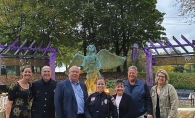Retired biologist Ron Refsnider introduces wide-eyed onlookers to the wonder of songbirds. He does this through educational bird banding demonstrations at Eastman Nature Center. Banding involves the safe capture of birds for identification, assessment and tracking. These demonstrations are an opportunity to see birds up close, ask questions and learn. Refsnider tries to get kids involved in releasing the birds at the end of each demonstration. Demonstrations are regularly offered to visitors for free every other month year-round at Eastman Nature Center.
Refsnider has been running the bird banding program since 1986. Once a biologist with U.S. Fish and Wildlife endangered species program, Refsnider first took up bird banding as a hobby. This particular hobby requires hobbyists to get involved only through a licensed bird bander because federal law or international treaty protects most birds from trapping.
The purpose of banding is to give each bird an individual identification number so that when banded birds are re-captured, experts can recognize them. Basic information is collected and sent to the bird banding laboratory co-run by the U.S. and Canadian governments. Collecting information from banded birds helps scientists to track bird migration.
The type of bird species monitored depends on the capture method used. Some bird banders specifically track raptors. Baited traps and mist nets made of very fine thread are used for the type of capture done by Refsnider. These nylon nets capture birds that are smaller than robins. Larger birds like blue jays or cardinals are typically able to free themselves.
“We mostly capture and study warblers and woodpeckers,” Refsnider says, noting other common species include sparrows, thrushes and chickadees. “Many birds return to the same place to nest year after year. It’s interesting to catch them over and over and watch for changes in feather or eye coloration.”
As a group, warblers are Refsnider’s favorite because they are brightly colored and tough to identify even when you hold them in your hand. He says, “We have to know the exact species before we band a bird.”
Banders also try to determine a bird’s sex and its age. “Woodpecker ages are easier to identify,” Refsnider says, “because of the way their feathers molt.”
Refsnider notes that the recapture rate for songbirds is incredibly small. Many bands are never found. “The average goldfinch or chickadee lives only 1-2 years,” says Refsnider. Birds must learn to survive predators, find food and get through the winter. Birds tend to do better at surviving each year after their first year. Five to six years old is pretty old for a goldfinch or a chickadee.
“We once captured a woodpecker over 14 years old,” Refsnider says. “That’s probably the third oldest woodpecker ever found.”
Although the recapture rate of smaller birds isn’t great, banding works well in managing waterfowl because hunters find and return many bird bands. The use of tiny transmitters is becoming more useful in tracking some smaller songbird species. Transmitters that were once too large for medium sized birds are now small enough to track small bird migration.
Banding can also help scientists learn more about declining bird populations. Many bird species decline due to loss or modification of habitat or nest by invading bird species parasitism. Refsnider says that bird lovers can help prevent declines in bird populations by not removing all dead branches or tree trunks from your property. “Many birds nest in cavities of dead trees,” Refsnider says. “And woodpeckers love dead trees for the insects they find there.”
Another way to bring more birds to your yard is to place bird feeders near shrubbery. Birds prefer to have a nearby place to flee to when they sense danger. Some like to grab a bit of seed and then go someplace safe and eat where they feel less exposed.
To begin identifying birds that come to your yard, Refsnider recommends checking websites or purchasing a field guide. “I still prefer the National Geographic Field Guide to the Birds of North America,” says Refsnider. “It’s laid out nicely and utilizes drawings instead of photographs. All the key markings are more visible in a drawing versus a photograph.”
So get out to a bird banding demonstration. Get yourself a field guide. And get familiar with the birds that fly by your window.
You can take part in banding activities this month. July 27, 9 a.m.–noon, Eastman Nature Center, 13351 Elm Creek Rd.; 763.694.7700; threeriversparks.org









